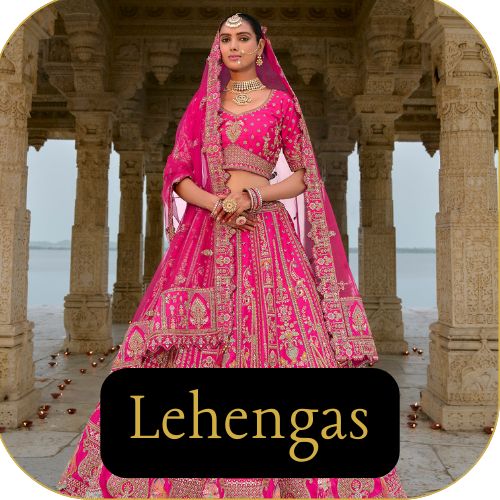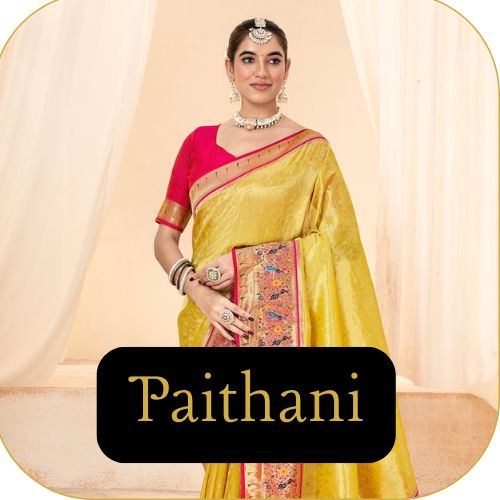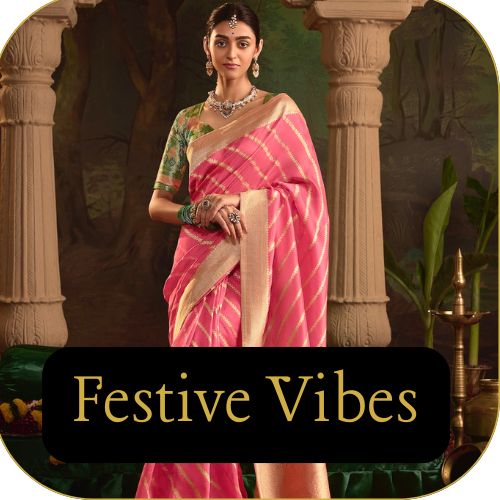Indian sarees, with their stunning diversity and timeless elegance, are a symbol of the country’s rich cultural heritage. Each region of India boasts its unique style of saree, reflecting the local traditions, craftsmanship, and history. Whether you're new to the world of sarees or a seasoned connoisseur, this comprehensive guide will introduce you to the many types of Indian sarees and their distinctive features.
Banarasi Saree
Origin: Varanasi, Uttar Pradesh
The Banarasi saree, known for its opulence and intricate designs, originates from the holy city of Varanasi. These sarees are woven with fine silk and adorned with intricate gold and silver brocade work, often featuring Mughal-inspired motifs such as floral and foliate patterns, kalga, and bel. A Banarasi saree is a must-have for weddings and grand celebrations.

Key Features:
- Rich silk fabric
- Intricate zari (gold and silver thread) work
- Detailed and elaborate designs
Kanjeevaram Saree
Origin: Kanchipuram, Tamil Nadu
Kanjeevaram sarees are renowned for their durability, vibrant colors, and rich silk fabric. These sarees are characterized by their heavy gold zari work and contrast borders. The motifs often include temple borders, checks, stripes, and floral patterns, making them perfect for festive occasions and weddings.

Key Features:
- Heavy silk fabric
- Rich gold zari work
- Contrast borders with traditional motifs
Chanderi Saree
Origin: Chanderi, Madhya Pradesh
Chanderi sarees are lightweight and sheer, making them perfect for summer wear. They are crafted from a blend of silk and cotton, with a glossy texture and delicate patterns. The sarees often feature traditional motifs such as peacocks, florals, and geometric designs.

Key Features:
- Lightweight and sheer fabric
- Glossy texture
- Delicate traditional motifs
Bandhani Saree
Origin: Gujarat and Rajasthan
Bandhani sarees, also known as Bandhej, are famous for their tie-dye technique, which creates distinctive patterns on the fabric. These sarees are known for their vibrant colors and intricate designs, often featuring dots, stripes, and waves. Bandhani sarees are perfect for festive occasions and cultural celebrations.
Key Features:
- Tie-dye technique
- Vibrant colors and intricate patterns
- Lightweight fabric
Paithani Saree
Origin: Maharashtra
Paithani sarees are a symbol of luxury and tradition in Maharashtra. Made from high-quality silk, these sarees are characterized by their vibrant colors, intricate zari work, and peacock motifs on the pallu (end piece). Paithani sarees are a popular choice for weddings and special occasions.

Key Features:
- High-quality silk fabric
- Intricate zari work
- Peacock motifs on the pallu
Tussar Silk Saree
Origin: Bihar, Jharkhand, and West Bengal
Tussar silk sarees are known for their natural gold sheen and rich texture. These sarees are handwoven from silk produced by the Tussar silkworm. They are lightweight, breathable, and often feature tribal motifs, making them a great choice for both casual and formal wear.
Key Features:
- Natural gold sheen
- Rich texture
- Lightweight and breathable
Assam Silk Saree
Origin: Assam
Assam silk sarees, particularly the Muga and Eri varieties, are renowned for their natural luster and durability. Muga silk, known as the golden silk of Assam, is particularly prized for its rich texture and longevity. These sarees often feature traditional Assamese motifs and are a symbol of elegance and grace.
Key Features:
- Natural luster and durability
- Rich texture
- Traditional Assamese motifs
Baluchari Saree
Origin: West Bengal
Baluchari sarees are known for their elaborate and intricate designs, often depicting mythological scenes and stories on the pallu and borders. These sarees are made from silk and are characterized by their rich colors and fine weaving. They are a popular choice for festive occasions and cultural events.
Key Features:
- Elaborate mythological motifs
- Rich colors and fine weaving
- Silk fabric
Sambalpuri Saree
Origin: Odisha
Sambalpuri sarees are famous for their unique ikat (tie-dye) patterns, which are woven into the fabric. These sarees are made from silk or cotton and often feature traditional motifs such as shankha (conch shell), chakra (wheel), and phula (flower). Sambalpuri sarees are known for their vibrant colors and intricate designs.
Key Features:
- Unique ikat patterns
- Traditional motifs
- Vibrant colors
Phulkari Saree
Origin: Punjab
Phulkari sarees are known for their vibrant embroidery, which features floral patterns made with colorful threads. These sarees are often made from cotton or chiffon and are characterized by their bright and cheerful designs. Phulkari sarees are a great choice for festive occasions and cultural celebrations.
Key Features:
- Vibrant floral embroidery
- Bright and cheerful designs
- Cotton or chiffon fabric
Kota Doria Saree
Origin: Kota, Rajasthan
Kota Doria sarees are lightweight and breathable, made from a unique blend of cotton and silk. These sarees are characterized by their checkered patterns, known as "khat," and often feature delicate embroidery or zari work. Kota Doria sarees are perfect for hot climates and everyday wear.
Key Features:
- Lightweight and breathable
- Checkered patterns
- Delicate embroidery or zari work
The diversity of Indian sarees is a testament to the country's rich cultural heritage and exceptional craftsmanship. Each type of saree tells a unique story, reflecting the traditions and artistry of its region. Whether you're attending a wedding, celebrating a festival, or simply looking to embrace the elegance of Indian fashion, there's a saree for every occasion. Explore these beautiful sarees and add a touch of timeless grace to your wardrobe.
















